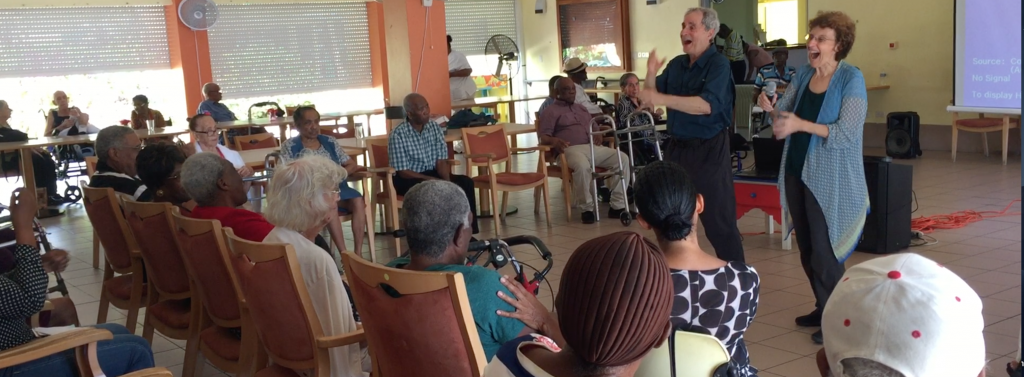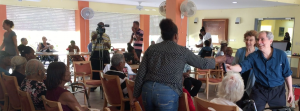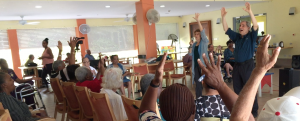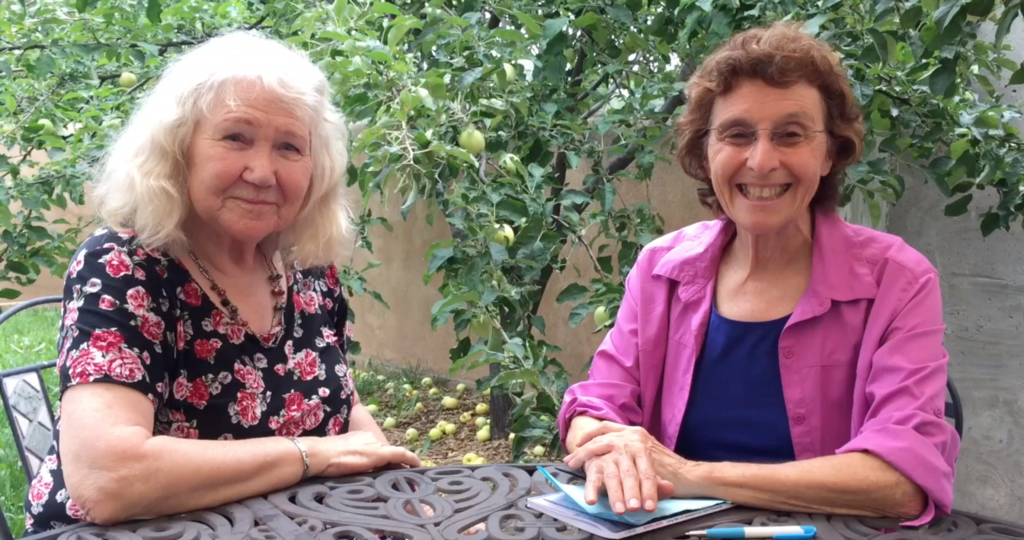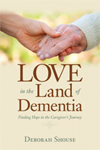Posts Tagged ‘caregivers’
Presenting to Community Members in the St. Martin’s Home, Along with Powerhouse Performer Raymond Jessurun
We knew that Raymond Jessurun was an amazing leader, organizer, and dementia advocate from our previous work with him in Philipsburg, St. Maarten. But we had no idea what a powerhouse performer he was until recently, when we presented with him at the island’s White and Yellow Cross Care Foundation.
On our way to the event, Raymond told us, “We have a mixture of people coming together, people from all over the world, people of varying abilities. We want to invite joy into their lives. We want everyone to connect and have fun together.”Ron and I loved the idea and focused on music and laughter as a common pathway. When we arrived at the care center, which is managed by the White and Yellow Cross Care Foundation, the community area was filled with light: the windows opened to the temperate breeze and lush outdoors. Indoors, in a large and cheerful room, people gathered in a semi-circle. Some had lived in Philipsburg all their lives. Others had relocated from other islands or countries, including Holland, Curaçao, St. Kitts, and Guyana.Raymond opened our session by telling everyone, “I want you to teach Deborah and Ron something about yourselves and about our country.”We all shared specific songs that reminded us of our families. Raymond jazzed us up by sliding into the center of the circle with a rousing a cappella rendition of Come on Let’s Twist Again. After a few bars, people were dancing in their seats. We kept the movement going as we conducted When the Saints Come Marching In, first in a stately tempo, then fast. We talked about the times of the day we liked to sing. Several of the care staff said they liked to sing throughout the day. One woman enjoyed singing in the afternoons. Another sang a poignant favorite of hers, about how she longed for someone to hold at night. She received a heartfelt round of applause.As part of our interaction about music and movement, we showed a video of Drum Safari engaging everyone in percussive activity during one of our KC Memory Cafes. We ended our session by giggling our way through some Laughter Yoga exercises, including drinking a delicious, no-cal, laughter milkshake.As a final treat, everyone serenaded us with a traditional national song, O Sweet Saint Maarten Land. (Link: https://www.youtube.com/watch?v=41capjzf7iQ) The ending stanza captures a taste of this beautiful country, but fails to mention its amazing people:“Oh I love thy Paradise,Nature beauty fairly nice,Oh I love thy Paradise,Nature beauty fairly nice.”
Quality Moments in the Land of Dementia: Laughing and Creativity in Jamaica
Our hosts started the program with a beautiful hymn of gratitude, a perfect way to acknowledge the spiritual aspects of connecting and laughing in the land of dementia. We met in the Salvation Army Church and Community Centre in historic downtown Falmouth, Jamaica, with a group of caregivers and community advocates. During our time together, we shared stories, information, laughter exercises, and creative ideas for taking care of ourselves and staying engaged.
 For many, this was an introduction to dementia. For others, who were in the midst of caregiving, this was a time of learning and sharing.
For many, this was an introduction to dementia. For others, who were in the midst of caregiving, this was a time of learning and sharing.
Ron and I talked about the importance of accepting each other as we are, no matter what we are going through. We discussed the power of having a purpose and how vital it is for all of us to have meaningful relationships and interesting experiences. .
”When communicating with people who are living with dementia, don’t argue,” Shirley Duncan reminded everyone. “Don’t criticize. Be there to support and appreciate.”
“When we are kind to ourselves, then we are better able to be kind to others,” one of our attendees said.
We discussed Dr. Cameron Camp’s concept of cognitive ramps, offering people the assistance they need 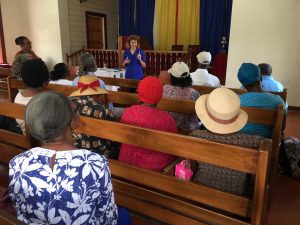 to remain engaged in the activities they love. Here’s one example from our session: Lorna’s mother was a professional cook, completely at home in the kitchen. As her dementia progressed, she could no longer remember the family’s favorite recipes. But she could sit in the kitchen and enjoy the energy of cooking. And when Lorna’s daughter said, “We are going to make your famous stew. Does it have an onion in it?” the mother smiled and nodded. Ingredient by ingredient, they consulted her, and she smiled and nodded at the mention of the right ingredients. Even though she wasn’t physically creating the meal, she was an integral part of the process.
to remain engaged in the activities they love. Here’s one example from our session: Lorna’s mother was a professional cook, completely at home in the kitchen. As her dementia progressed, she could no longer remember the family’s favorite recipes. But she could sit in the kitchen and enjoy the energy of cooking. And when Lorna’s daughter said, “We are going to make your famous stew. Does it have an onion in it?” the mother smiled and nodded. Ingredient by ingredient, they consulted her, and she smiled and nodded at the mention of the right ingredients. Even though she wasn’t physically creating the meal, she was an integral part of the process.
We talked about the power of music, sharing ideas from Dan Cohen’s Music and Memory program and introduced people to the personal playlist. We had an impromptu Conductorcise session, using Maestro David Dworkin’s aerobic and ground-breaking program, pretending we were conducting a symphony orchestra. We used laughter syllables to make it even more fun and soon everyone was standing up and conducting and laughing.
We shared a story from Karen Stobbe, reminding us all to affirm and appreciate and to use the improv technique, “Yes and…” to ignite and invite conversation.
Throughout our discussion, we wove in laughter exercises.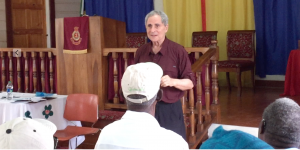
We enjoyed an imaginary laughter swim. We batted around laughter balloons and cooked up a laughter stew that included fish, pumpkin, garlic, carrots, Irish potatoes and okra.
At the end, we breathed in our gratitudes, closed our eyes and sent our feelings of love, connection, and laughter into the world, hopefully to help and inspire others.
Click here for a small taste of this lively workshop:
A special thanks for the dementia advocates and community volunteers who brought everything together, including Dundeen Ferguson, Shirley Duncan, Sandra Latibeaudiere, Elise Thomas, and Lorna Colley. And thanks to everyone who attended.
Deborah Shouse is the author of Connecting in the Land of Dementia: Creative Activities to Explore Together and Love in the Land of Dementia: Finding Hope in the Caregiver’s Journey.
Laughing for Health and Happiness in St. Thomas
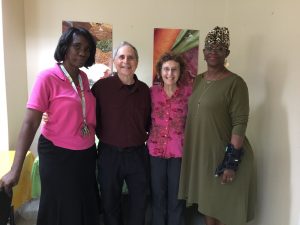 The people of St. Thomas have been through a lot and many are still recovering from Hurricane Maria. But despite the hardships, they were ready to laugh for health and happiness. We were delighted to be working with our friend Arleen Evans O’Reilly, Director of the Family Caregiver Support Program, offering a laughter yoga class in St. Thomas. We met at the senior center and had a wonderful time facilitating laughter with seniors, caregivers, and people who are living with dementia. CLICK HERE to experience a glimpse of our session.
The people of St. Thomas have been through a lot and many are still recovering from Hurricane Maria. But despite the hardships, they were ready to laugh for health and happiness. We were delighted to be working with our friend Arleen Evans O’Reilly, Director of the Family Caregiver Support Program, offering a laughter yoga class in St. Thomas. We met at the senior center and had a wonderful time facilitating laughter with seniors, caregivers, and people who are living with dementia. CLICK HERE to experience a glimpse of our session.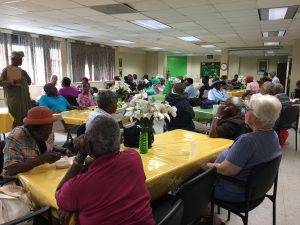
We have been experimenting with making our laughter sessions increasingly interactive. We invited our attendees to suggest ingredients for the stew and it included chicken, pumpkin, onions, carrots, potatoes, and bullion. After we added and stirred, we tasted and it was both delicious and “funny” tasting.
For our milkshake, we first asked people what ice cream they want to use. We had a lot of chocolate lovers. A few enjoyed vanilla and strawberry. We also had fans of praline cream, banana, and cherry Garcia. We held an imaginary container in one hand and we poured milk with the other hand and and said, “Ha ha ha.” After doing that three times, we scooped in our ice cream three times, adding in laughter syllables. Then, with both hands, we shook and laughed. Finally, we tasted and enjoyed a good giggle.
Ron and I continue to explore ways to add more laughter into our every day lives. The benefits of sustained intentional laughter include reducing stress, lowering blood pressure, boosting the immune system, increasing oxygen to the brain, creating a sense of connection and community, and increasing feelings of happiness. Plus, laughter offers us aerobic exercise.
Here are some of the way we’re adding extra laughter into the day:
- Laughing while we exercise. Squats are much more fun when you’re giggling as you do them.
- Adding laughter activities in while we walk.
- Singing “Ha Ha” syllables to favorite tunes. Even a simple, Row Row Row Your Boat, with Ha ha syllables, makes us laugh.
- Looking at the clock and deciding, “We’re going to laugh for one minute.”
We often visit Robert Rivest’s site for short ten-minute laughter videos, which cheer us onward. Laughteryoga.org offers more great resources. And we have fun creating our own laughter activities. If you have laughing ideas you want to share, we’d love to hear from you.
Deborah Shouse is the author of Connecting in the Land of Dementia: Creative Activities to Explore Together and Love in the Land of Dementia: Finding Hope in the Caregiver’s Journey.
Pick the Best Care Community for Your Loved One
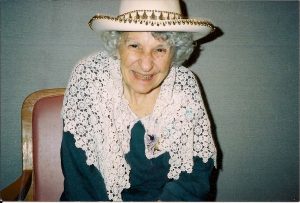
My hands were sweating as Mom, Dad, and I entered the memory care unit. We desperately wanted to pick the best care community for my mother. Pam, the head nurse, rushed towards us, arms outstretched.
“So good to see you again,” she told my father and me. She turned to Mom. “And you must be Frances. Paul has told me so much about you. I hear you’re a nurse too.”
She took Mom’s arm and they walked together down the corridor, talking. We followed and Pam stopped at a small dining area, where coffee and cookies, chocolate chip, one of Mom’s favorites, awaited us. Dad and I looked at each other and smiled. Maybe, just maybe, this was going to be all right.
We had already visited several homes and none of them seemed warm enough, caring enough, or quiet enough for Mom. What had won us over was Pam and her feeling for people who were living with memory loss, her determination to create community, her compassionate and easy way of communicating.
#
One of the most challenging experiences caregivers can face is finding the right community when your loved one needs care. Jytte Lokvig, PhD, regularly consults with families on this issue. Her new book, Moving & More, offers families concrete guidelines for finding the facility that meets their needs.
Click here to see our interview with Jytte Lokvig
When visiting a care community, Jytte suggests that we ignore the lobby and the landscaping. A beautiful lobby soothes the family’s soul but has little to do with the quality of care and engagement offered. Spend at least a couple of hours in memory care.
“Remember,” she says, “you are asking your loved one to live here. Stay on after your tour and blend into the scenery, so you can really get a sense of how staff and residents interact.”
Here’s what you want to learn:
- Does the facility practice “Person centered-care?
- Do residents participate in menu and activity choices?
- What is the staff/resident ratio?
- What are the staff retention rates?
- Do all staff receive mandatory first aid and dementia training?
- Are the family, nurse, personal care and activity staff involved in creating the resident’s care plans?
- Does the activities calendar offer a blend of entertainment and interaction?
- Are there both individual, small group, and large group activities?
- Does the staff acknowledge each resident, even with a simple greeting or compliment?
After you have a sense of the community, take your loved one to visit. Have a meal with the residents. Stay for an activity program.
“Several visits like this helps both of you feel more comfortable when the move comes,” Jytte says.
For more tips and information, visit Jytte’s site at http://www.alzheimersatoz.com and consider her book: Moving and More.
Deborah Shouse is the author of Connecting in the Land of Dementia: Creative Activities to Explore Together and Love in the Land of Dementia: Finding Hope in the Caregiver’s Journey.
Connected in the Land of Dementia: Easy Ideas and Free Events
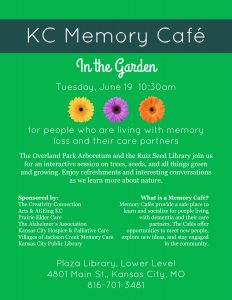
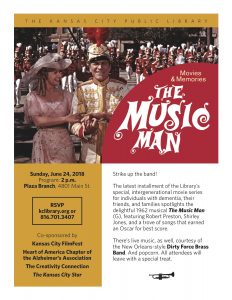

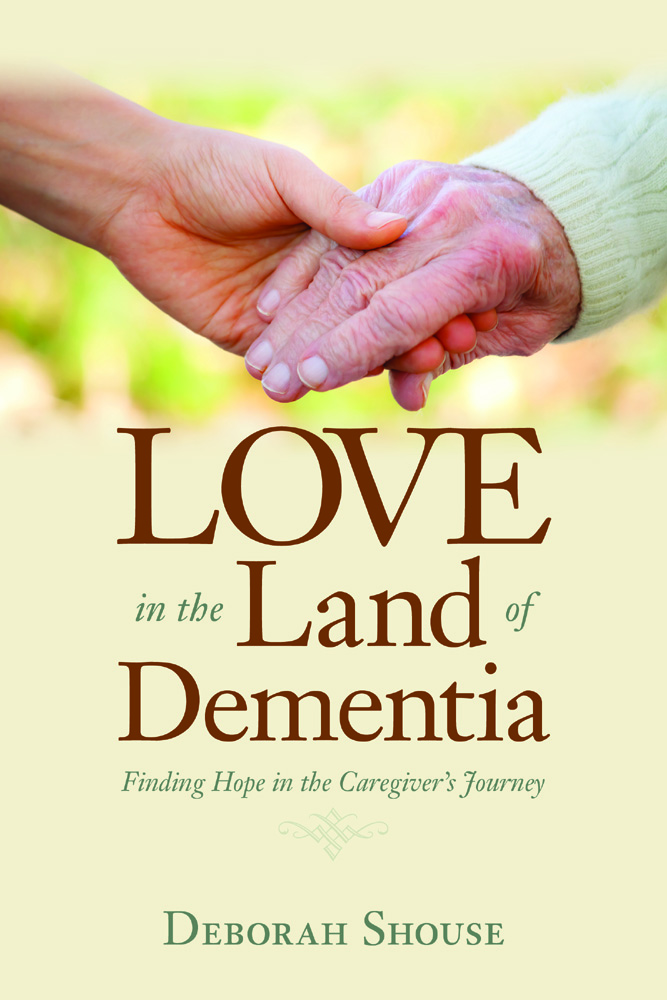
My Mom’s New Holiday Tradition: Smiling
**
We roll into the memory care facility’s dining room just as the show is ready to start. The singer, Thelda, kicks off her shoes and presses play on the boom box. Above the cheerful sound track, she sings Jingle Bells. She dances across the room with the remnants of ballroom steps. She stops in front of Mom and sings right to her. She gets on her knees, so she can look into Mom’s eyes, and keeps singing. Mom notices her and smiles a little.
Thelda moves on, singing to each of the patients gathered around, so intent on making a connection that she often forgets the words.
“Is it all right for your Mom to come to Christmas holiday events?” the activity director had asked me, when Mom moved in.
“Yes, I’d like her to go to any activities. She likes the extra energy.”
I think Mom would approve of my decision, even though she has never celebrated Christmas. Growing up, her immigrant mother held on to the Jewish spirit of her home, kneading dough for Friday evening challah, observing each holiday and prayer period in her own way. Some orthodox women followed the religious law that commanded a small piece of the dough be burned as an offering to God. My grandmother was poor; she did not believe in burning good food, regardless of tradition. So she sacrificed a portion of the dough to her youngest daughter, my mother Fran. She created a “bread tail,” leftover dough that she baked, then smeared with butter and sprinkled with sugar . When Mom used to talk about her mother, she always mentioned this special treat.
Even when I was growing up, and we were the only Jewish family in our neighborhood, my mother still did not sing Christmas song. She let the holiday rush by her, like a large train, whooshing past and leaving her behind.
 Now, I am singing Christmas carols to my Mom for the first time and she is smiling. She has moved beyond the place where the religions are different, beyond the place where she wants to separate the dough and make a sacrifice for tradition. Her new tradition is anyone who can make her smile.
Now, I am singing Christmas carols to my Mom for the first time and she is smiling. She has moved beyond the place where the religions are different, beyond the place where she wants to separate the dough and make a sacrifice for tradition. Her new tradition is anyone who can make her smile.
With each song, from White Christmas, to Silver Bells, to Frosty the Snowman, Thelda moves back to Mom, tapping her, acting sillier and sillier. Each time, Mom lifts her head and widens her mouth for a second.
For her finale, Thelda puts on a big red nose and sings Rudolph. When she dances in front of Mom with that scarlet nose, Mom laughs, her face a miracle in pure enjoyment. I laugh too, so delighted to see Mom engaged and absorbed.
Two weeks from now, I will bring a menorah and candles into my mother’s room. My father and I will have a short Chanukah ceremony with Mom. She will pick at the shiny paper covering the Chanukah gelt (chocolate candy disguised as money). She will slump over in her chair. But she will come back to life when she sees me, her only daughter, wearing a big red nose as I light the menorah.Here’s to a meaningful and fun holiday season.
I look forward to connecting with you when I resume blogging in early January.


Chocolate Boosts Brain Health!
As the daughter of someone who lived with dementia, I do a lot of things to boost my brain health. I try to walk 10,000 steps a day, along with other exercise. I eat blueberries and broccoli. I do squats, try to memorize a few words of Spanish, and think about taking harmonica lessons. I try new things, laugh often, and practice drawing. But a recent study revealed that I was intuitively doing something else that was cheering on my brain, something I hadn’t even counted. Just in time for Halloween, it turns out Chocolate Boosts Brain Health!
I recently encountered a fascinating study on the Harvard Health website, and was intrigued when I read this headline: Cocoa: a sweet treat for the brain
Imagine being in Italy and contributing to scientific research by drinking a luscious dark cocoa drink every day for eight weeks. Then imagine feeling even more lucid, vibrant, and healthy after that experience. That is the essence of the Cocoa, Cognition, and Aging (CoCoA) Study, published in the American Journal of Clinical Nutrition in December 2014, with this flavorful title: Cocoa flavanol consumption improves cognitive function, blood pressure control, and metabolic profile in elderly subjects. (Note: It turns out some of the “elderly” subjects are as young as 61, an age some of us may argue is merely “middle-age.”)
A Chocolate Boost Makes Your Brain Boast
I am also in love with this Maine-Syracuse Longitudinal Study (MSLS), of 968 people that includes these mouth-watering assertions:
All cognitive scores were significantly higher in those who consumed chocolate at least once per week, than in those who never/rarely consumed chocolate.
“More frequent chocolate consumption was significantly associated with better performance on the Global Composite score, Visual-Spatial Memory and Organization, Working Memory, Scanning and Tracking, Abstract Reasoning, and the Mini-Mental State Examination,” said the research team, which included scientists from the University of Maine.
More Delicious Cocoa-flavored News
And another study from Loma Linda University, states:
“Dark chocolate, which is 70 percent cacao, is a major source of flavonoids –- powerful antioxidant and anti-inflammatory components that are known to be beneficial to cardiovascular health. The California team’s initial studies at Loma Linda University have shown that absorbed cacao flavonoids penetrate and accumulate in regions of the brain associated with learning and memory.”
“We are tremendously excited about what these findings could potentially mean for brain health,” said Lee Berk, DrPH, MPH, who led the team. “This may open the door for potential restorative uses for individuals with memory/recall or dementia and aging-related issues.”
Never Forget To Boost Your Brain
I now have a remedy for those days when I’m too tired to exercise, too busy for a crossword, too cranky for a brain game. Or for when I simply forget. On those days, I’ll simply treat myself to a taste of the dark side. And hope it leads me towards the light.
Want to learn more?
http://www.goodnewsnetwork.org/study-confirms-brain-and-memory-benefits-from-dark-chocolate/
http://www.health.harvard.edu/blog/cocoa


Insider Dementia Friendly Travel Tips, from Laurie Scherrer
This year, Laurie Scherrer is taking a number of trips: Atlanta, to speak at a conference, South Carolina, for a family reunion, and the Caribbean, as a speaker and participant in a dementia-friendly cruise. Since she is living with early onset dementia, Laurie plans out her trips, taking into consideration her needs and the chaos that can be a natural part of any journey. Here are some insider dementia friendly travel tips from Laurie.
Planning for a Smooth Flight
Laurie contacts TSA and her airline, notifying them of her disability, so they can mark it on her ticket. She and her husband both paid for a TSA pass, so they can go in together. That helps her avoid the bombarding noise, distraction, and exhausting wait inherent in a long check-in line
“The TSA staff will walk you through the line,” she says.
Laurie is sensitive to noises, so the constant airport announcements, the din of hundreds of conversations, and the drone of background sounds present challenges.
“I walk into a restaurant and I hear the clanging of the dishes, the forks on the plates, the waiter’s shoes thudding against the floor,” she says. “I have lost my ability to filter sound, and those noises are as strong as any conversation I’m having.”
To minimize distraction and confusion and to help her concentrate, Laurie often wears noise-cancelling headsets.
Once in the airport, she tries to find a quiet place to sit.
“I don’t sit at the gate for two hours with a slew of people,” she says. “Sometimes a restaurant or bar is quiet. For overseas trips, you can try to get access to an airport lounge.”
She tries to get a seat towards the front of the plane, to avoid additional waiting and wading through a crush of passengers.
Packing it Up
Two weeks before a trip, Laurie organizes her clothes for each day. She puts on an outfit, then takes a picture of it.
“On the picture I write, ‘Purple shirt, black slacks, white sneakers, white socks, etc.,’” she says. “Then when I pack, I put each day’s entire outfit together, including socks and underwear. That makes getting dressed so much easier.”
Getting Oriented
At any new hotel, Laurie and her husband walk around the entire building so Laurie can get oriented. When she is traveling alone, she talks to the hotel manager, to explain her situation. At one lodge, the receptionist escorted Laurie to her room and helped her unpack. Laurie carries a tag with her name and room number on it, in case of sudden confusion.
“Don’t be afraid to ask for help,” she says.
Taking Breaks
Laurie has already planned her quiet time and her personal getaways for the upcoming cruise, where she is both a traveler and a speaker/educator.
“On cruise ships, the library is often a quiet haven,” she says.
She also avoids group shore excursions, as it is hard for her to enjoy being in a crowd.
But it’s not hard for Laurie to relish travel and to revel in engaging in new experiences and meeting new people. It just takes a little planning and a lot of taking care of herself. #
To learn more about Laurie, visit https://dementiadaze.com/about-me/


The Marvels of Misplacing
“I don’t know where my glasses are,” Mom tells me. I bite my lip; she’s been misplacing things all day. We are supposed to be spending a day drawing and painting, trying to connect mom with the artist she used to be. We are supposed to bake cookies together and look through magazines. But I’ve been spending much of the time crawling around, looking under the sofa and chairs and between the cushions for the disappearing glasses.
“Let’s make our cookies. You won’t need your glasses for that,” I say.
“I need my glasses.”
As I search, I wonder when it became a drudgery instead of a joy to find things. One of my favorite childhood games was Hide ‘N Seek. I loved being the Seeker, loved the surprise of finding someone in a tucked away, mysterious place. I had a special trick I used when I was “It.” I would close my eyes and say, “If I were Dan, where would I hide?” Then an image floated into my mind and I’d race to the hiding place. Half the time, I was right.
Do I still have “it?” I close my eyes and think, “If I were Mom’s glasses, where would I be?” The refrigerator comes to my mind. I rush into the kitchen and fling open the refrigerator door, only to see the usual chaos. But I’m hungry, so I reach for an apple. Behind the fruit is a pair of reading glasses, sprawled across the shelf.
Triumphantly, I take the glasses to Mom.
“These feel nice,” she says.
Not only has my mother reminded me of the importance of creativity, curiosity and play, but she also discovered a great summer time tip: chill your glasses and cool off your face.
Deborah Shouse is the author of Connecting in the Land of Dementia: Creative Activities to Explore Together and Love in the Land of Dementia: Finding Hope in the Caregiver’s Journey.
Boost Body and Spirit with Nature: Tips for Care Partners and People Living with Dementia
“I can’t imagine a world where I couldn’t enjoy outdoor pleasures whenever I want,” said Mike Good, founder of Together in This. As I listened to Mike’s Podcast on the power of nature, I thought of my mother. Mom taught me to love birds, flowers, trees, and mountains. Even in her last days, a yellow rose could catch her attention, inspire her to reach out and touch its tender petals. This simple activity helped boost body and spirit with nature.
There’s increasing research that backs up what I observed with my mom. Strolling or wheeling around a courtyard, sitting on a bench underneath an apple tree, observing a bunny nibble clover, watching someone water a tomato plant — all these outdoor events enhance physical and mental well-being, including improving sleep cycles and reducing agitation.
Garuth Chalfont, PhD, American Society of Landscape Architects, and author of the book, Dementia Green Care, says, “Nature-oriented activities, such as growing and caring for plants, promote brain neuroplasticity and help us dream, experiment, learn and create. Research shows that nature-based activity is therapeutic and is essentially a form of treatment for dementia symptoms, helping a person remain at home longer.” Garuth is internationally known for his work in designing, building, and researching gardens that benefit people with dementia.
Mike Good says, “The feel of sunshine on my face, the smell of flowers blooming, the sounds of kids frolicking in the park — while these pleasures naturally occur for most of us, millions of people who are living with dementia find themselves unable to enjoy such routine pleasures without assistance”
Taking a loved one who is living with dementia outdoors can be stressful, but staying cooped up inside is hard on both of you. Here is a bouquet of nature’s benefits, inspiring for both people who are living with dementia and those who care for them.
Relaxing outdoor activities
Gardening activities, such as container gardening, planting seeds, watering, weeding, harvesting, sharing flowers and fruits and vegetables
Walking around the yard or strolling through the neighborhood
Discussing people and dogs walking by, asking open-ended questions, such as “Where do you think they’re going?”
Installing a small fountain and a bench, then sitting and enjoying the sound of the water
Sharing a picnic lunch
Drawing or painting outdoors
For those who enjoy projects, have tools visible and available. For a woodworker, set out wood and sandpaper. For a frail gardener, have a container of herbs. For those who like to tidy the yard, offer gardening gloves and a bucket to deposit leaves and twigs.
Bringing Nature Indoors
Garuth says, “If going outdoors is not feasible, look around your living quarters and ask, ‘Where are the best outdoor views? Where is the most sunlight?’ You may need to cut down a light-blocking bush or move a sofa, but you will discover areas where you and your partner can enjoy sitting and watching nature.”
Open the curtains and blinds to let in light.
In temperate weather, open windows and welcome fresh air and birdsong.
Green up the room with houseplants.
Bring in flowers or herbs to stimulate the senses.
Create a comfortable viewing area, with feeders, so you can enjoy watching birds and squirrels.
Gather potting soil, water, and green bean seeds. Spoon the soil into small pots or into an empty egg carton. Place one seed in each and cover with soil, then pour in a little water.
“Touching soil and planting may trigger memories and ideas from earlier years,” Garuth says.
Gathering flowers, walking a tree-lined sidewalk, plucking a cherry tomato off its vine, watering a house plant, gazing out the window at chickadees — these meaningful natural activities increase pleasure, relaxation, social interactions, and sensory stimulation.
For more information about Mike Good and his work, visit http://togetherinthis.com/ and view his nature video at https://www.youtube.com/watch?v=P7KWaSUHVQo
To learn more about Garuth’s work, visit http://www.chalfontdesign.com/ and http://www.chalfontdesign.com/lifework.html
Deborah Shouse is the author of Connecting in the Land of Dementia: Creative Activities to Explore Together and Love in the Land of Dementia: Finding Hope in the Caregiver’s Journey.
